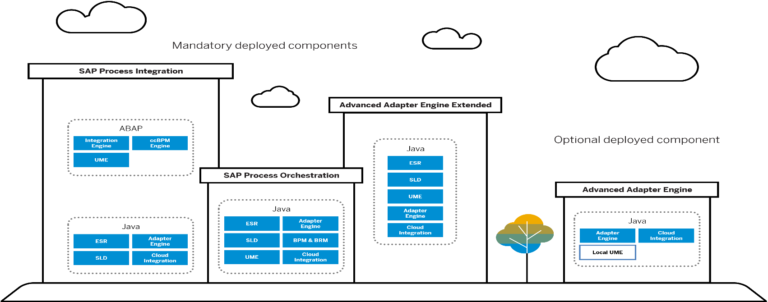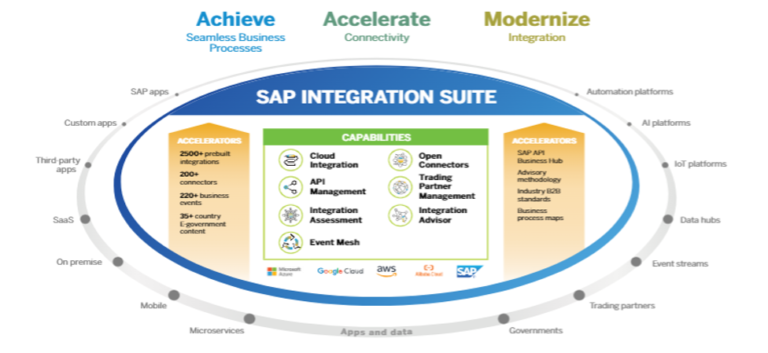Choosing Between SAP PO and SAP Integration Suite on BTP: Key Decision Factors Explained
Did you know that we can implement your SAP BTP Integration Suite remotely. Benefit from our accelerators, certified consultants and experience.
SAP Integration – Primary Options
SAP primarily offers 2 solutions in the Application Integration space:
- SAP Process Orchestration 7.5 (SAP PO)
- SAP Cloud Integration (SAP CI), offered as part of Integration Suite (SAP IS)
SAP PO is a solid on-premise middleware that has been around for 20+ years and used by more than 12,500 customers. SAP will be providing extended maintenance for PO 7.5 until 2030.
SAP IS is an Integration Platform as a Service (IPaaS) solution. It is a logical successor of SAP PO for companies that are looking to move their applications and integrations to the cloud.
SAP PO – Highlights
- Formerly knows as SAP XI (Exchange Infrastructure), SAP PI (Process Integration)
- A reliable and stable integration platform for Application-to-application integration (Synchronous & Asynchronous)
- Supports Integration between cloud and on-premise/ground applications
- Includes rich set of adapters & user-friendly GUI
- Unmatched Monitoring tool where you can reprocess error messages
- Repository to Build, Store & Reuse Structures, Mappings etc.
- A Large & helpful developer community
- Strong B2B solutions using the optional Add-on

SAP PO – Deployment Options
SAP Integration Suite – Highlights
- Formerly knows as SAP HCI (HANA Cloud Integration), SAP CPI (Cloud Platform Integration). Presently knows as SAP CI, part of the SAP IS (iPaaS) which in-turn is part of SAP Business Technology Platform (SAP BTP), a cloud-based Platform as a Service (PaaS)
- Best suited for Integration between cloud-cloud and cloud-ground solutions
- Supports seamless integration with other SAP cloud solutions like S/4HANA, C/4HANA, Success Factors, Ariba, Concur, Fieldglass etc. through pre-packaged content.
- A complete Integration solution supported by capabilities like SAP Open Connectors, API Management, Integration Advisor.
- Uses Apache Camel open-source framework.

SAP Integration Suite – components
SAP PO versus SAP Integration Suite - Architecture
Criteria | SAP PO | SAP IS |
Pipeline | Fixed pipeline: Connectivity->Routing->Mapping->Connectivity | Flexible Pipeline |
Stateful Message Processing | Mainly part of BPM | Integrated in iFlow. In addition, there is a powerful Data Store to persist data. |
Separation of Design & Configuration | ESR for design time artifacts, DIR for configuration. | Mainly managed in the iFlow. Configurable Elements can be externalized, Users are managed also outside of iFlows. |
Interface Modeling | Interfaces can be modeled with data type editors | No modeling environment available. Interface definitions must be imported. Import of ESR Objects possible. |
Content Organization & Reuse | Strong governance enables reuse of integration content globally. | Each iFlow is autonomous, lean & independent. Using the ProcessDirect Adapter, certain functionality can be centralized. Credentials, Scripts & Mappings can be reused. |
Re-process Error Messages (Asynchronous) | Inbuilt functionality to reprocess error messages | No inbuilt functionality available. Can be achieved with the help of data store and custom-built iFlow. |
Architecture | Single Tenant solution, no built-in virtualization capabilities. Failover to be configured by customer | Multi-tenancy, data isolation, virtualization is possible. Automated failover and rolling software updates |
SAP PO vs SAP IS – Use Cases
Use Case | Recommendation |
Ground <-> Ground Integrations | Use SAP PO |
Cloud <-> Ground Integrations | SAP IS recommended. However, SAP PO can also be used |
Cloud <-> Cloud Integrations | Use SAP IS |
Integrating SAP Cloud Solutions | Use SAP IS |
Brand new SAP Implementation (No SAP PI/PO in the current landscape) | Use SAP IS |
Have older SAP PI in the landscape | You can either Migrate to SAP IS (If you have <50 interfaces) or Migrate to SAP PO 7.5 (>50 interfaces) (You can migrate to SAP IS slowly) |
Already on SAP PO 7.5? | Continue to develop new interfaces with existing systems on SAP PO If you are implementing new cloud solutions involving SAP systems, go with SAP IS as you can benefit from the pre-delivered content. |
SAP PO vs SAP IS – Key Differences
Criteria | SAP PO | SAP IS |
Deployment | On-premise installation in customer landscape. Responsibility lies with customer | Cloud based service hosted by SAP. Can also be deployed on AWS, Azure, Alibaba Cloud. Responsibility lies with SAP |
License Model | Core-based Product License and Annual Fee | Monthly Subscription Fee (see: Licensing) |
Pre-packaged content | Limited | 2500+ pre-built integrations |
Software updates | Needs to be installed by your Basis team | SAP automatically pushes new updates every month |
B2B Support | Supported via B2B add-on | Supported via Trade Partner Management |
Scalability | Additional nodes/servers can be added | Highly scalable as it is cloud-based |
Asynchronous Messaging | Guaranteed delivery in Exactly Once (EO) / Exactly Once In Order (EOIO) mode | Transient Cloud messaging by default. EOIO is not available and EO must be modelled manually using Data store or via JMS |
Number of Adapters/Connectors | 20+ | 190+ (30+ Standard connectors and 160+ connectors to non-SAP Cloud applications supported by SAP Open Connectors) |
SAP PO vs SAP IS - Key Decision Criteria
1.Do you already have an existing SAP PI/PO System?
If your answer is No, then we recommend you invest in SAP IS and create all your future integrations using SAP IS. SAP IS (aka Cloud Platform Integration – CPI) supports integrations between cloud <-> cloud, cloud <-> on-premise and on-premise <-> on-premise systems. Else, SAP PO can stay as a central Integration platform until your business needs change.
2.Do you have significant integrations between on-premise Systems?
If yes, then you can go with Hybrid approach where you can continue using SAP PO for your existing ground to ground integrations and slowly move your cloud integrations to SAP IS.
3.Does your Integration team have the right skills?
Another factor to consider is if your integration team has the right skills and are ready to learn the ever-evolving skillet required to get onboard with SAP IS.
4.Are you planning to move most of your critical business applications to the cloud?
SAP IS should be the choice in this case. You can gradually move your existing integrations from SAP PO to SAP IS.
5.Your company’s long-term vision and SAP’s future roadmap
If you plan to move all your business processes to the cloud, SAP IS is the right choice. It also aligns with SAP’s roadmap. All of SAP’s main solutions have adopted cloud and will soon provide services via a single data model: SAP BTP powered by SAP HANA.
6.Do you have the budget for the Technology upgrade?
This is not only a decision based on current state licensing, but also current and future maintenance costs and development time for future integrations to SAP and non SAP applications.
